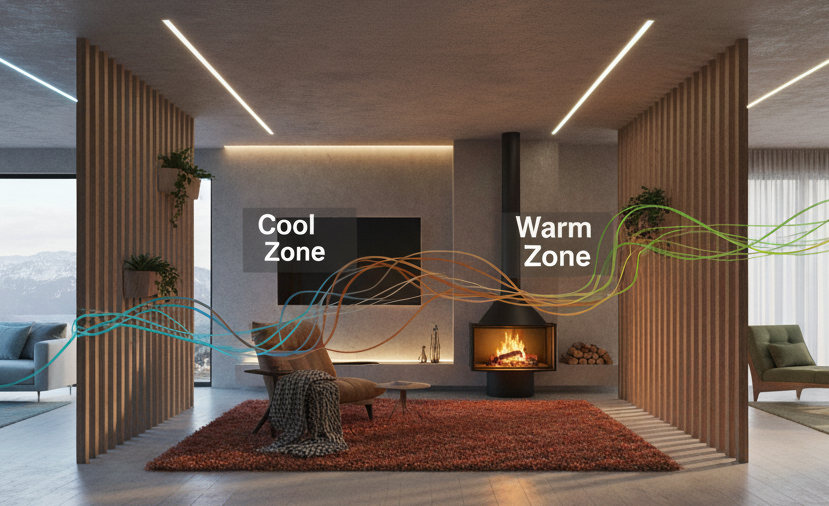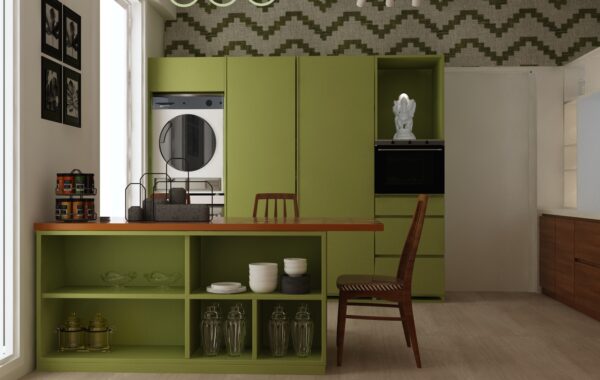Imagine walking into a room that instantly feels right—not just visually, but physically. The air is the perfect temperature for what you’re doing, whether it’s curling up with a book, hosting dinner, or getting focused work done. It’s not luck. It’s thermal zoning—the next evolution in personalized interior design.
As a world-class interior designer deeply invested in the intersection of neuroscience, sustainability, and comfort, I believe that temperature is one of the most overlooked tools in spatial design. While we obsess over textures, colors, and layout, the invisible element of how warm or cool a room feels has a powerful impact on mood, focus, sleep quality, and even relationships.
Let’s explore what thermal zoning means, why it matters, and how to use it to design interiors that align with human comfort at a biological level.

🔥 What is Thermal Zoning?
Thermal zoning is the practice of designing and regulating different areas of a home based on varying temperature needs and bodily comfort levels. Rather than treating your house as one big climate box, you break it into zones—each tailored to how the space is used and how the body responds to it.
It’s used in architecture and HVAC planning, but the interior design layer adds texture, function, and user experience. A well-zoned home doesn’t just save energy—it boosts well-being and day-to-day satisfaction.
🧠 Why Body Temperature Affects Mood and Function
Humans are thermally sensitive. A space that’s too warm can cause fatigue, sluggishness, or irritability. One that’s too cold can increase anxiety and reduce focus. Thermal comfort supports everything from productivity to emotional regulation.
Key bodily temperature cues:
- Cooler environments help promote alertness and focus.
- Warmer environments encourage relaxation, social bonding, and sleep.
- Individual preferences vary: women often prefer warmer spaces, while men often prefer cooler ones.
- Circadian rhythms shift body temperature throughout the day—designing with this in mind creates harmony with biology.
🏡 How to Apply Thermal Zoning in Interior Design
Here’s how to design with thermal intention—creating rooms that feel intuitively right based on how we live and what our bodies need.
The Cool Zone: Work, Exercise, and Alert Tasks
Best Rooms: Home office, gym, kitchen
Optimal Range: 20–22°C (68–72°F)
Why: Slightly cooler temperatures keep the brain alert and prevent drowsiness.
Design Strategies:
- Use fans or cross-ventilation to create natural airflow.
- Install lighter textiles like linen curtains or mesh office chairs.
- Position workspaces away from direct afternoon sun exposure.
- Choose cooling tones—blues, greys, whites—to reinforce a crisp mental tone.
Quiet design bonus: a cooler work zone can help reduce screen fatigue and maintain energy levels throughout long tasks.
The Warm Zone: Rest, Bonding, and Stillness
Best Rooms: Bedroom, living room, dining area
Optimal Range: 22–24°C (72–75°F)
Why: Warmer spaces promote relaxation, comfort, and oxytocin release (the bonding hormone).
Design Strategies:
- Use plush materials—velvet, wool throws, soft rugs—to trap and reflect warmth.
- Position seating near southern windows for passive heat gain.
- Add ambient lighting or candles to visually “warm up” the space.
- Choose richer color palettes—earth tones, terracotta, caramel, wine—to match the sensory warmth.
This zone is ideal for winding down after a long day or encouraging intimate, slow-paced connection.
The Adaptive Zone: Personal Control Spaces
Best Rooms: Guest room, meditation corner, reading nook
Optimal Range: Adjustable (personal control preferred)
Why: Some spaces need flexibility—especially shared or solo-use areas.
Design Strategies:
- Provide layered textiles: throws, pillows, blackout curtains, or heating pads.
- Use portable heaters or fans discreetly hidden in cabinetry or under benches.
- Offer lighting dimmers and dual-function fixtures (e.g., cool white to warm amber).
- Allow for multiple seating options—some near radiators, others near windows.
These zones empower users to regulate their comfort based on mood, body type, or season—making the space emotionally intelligent.
🧺 Textiles as Thermal Tools
Beyond HVAC systems, your materials can become micro-climate controllers:
- Wool and fleece: Excellent for retaining heat in living areas and bedrooms.
- Linen and cotton: Naturally breathable—ideal for offices and warmer climates.
- Rugs: Prevent heat loss through flooring; thicker piles retain more warmth.
- Sheers vs. heavy drapes: Control how sunlight and heat move through the room.
These design choices influence how a room feels on the skin, even if the thermostat doesn’t change.
🌿 Sustainable Bonus: Save Energy by Designing Smart Zones
Thermal zoning isn’t just about comfort—it’s deeply sustainable. By warming or cooling only the areas in active use, you:
- Reduce HVAC load
- Lower your utility bills
- Extend the lifespan of mechanical systems
- Align with green building standards
Designing with purpose means designing for both people and planet.
🧘 Final Thought: Comfort Is Not One-Size-Fits-All
Most design philosophies treat temperature as an afterthought. But in reality, it’s one of the most personal, primal, and persistent sensations we experience in a space.
Thermal zoning is about more than tech—it’s about empathy. It’s designing for how people live, rest, and move. It’s understanding that one person’s cozy is another’s stifling. That productivity, pleasure, and peace all live in different temperature zones.
When your home is thermally intuitive, it doesn’t just look good. It feels like it knows you.


